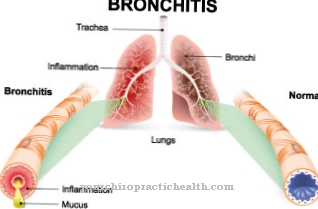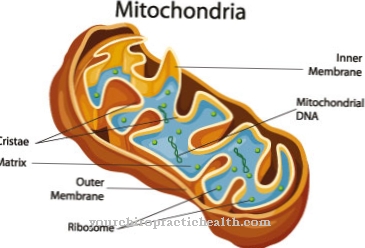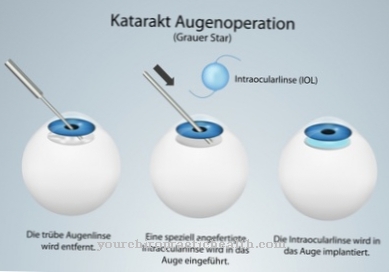A Muscle strain is, in addition to muscle hardening, a typical and frequently occurring sports injury. Just like the muscle fiber tear, the muscle strain is one of the closed muscle injuries, since only the muscle is affected. Outwardly, however, nothing can be seen that would suggest a strain.
What is a muscle strain?

© Henrie - stock.adobe.com
Above all, athletes know them very well: the Muscle strain. With this injury, the skin remains intact, so it is a closed muscle injury (see also sports injuries). Depending on which parts of the body are stressed, the strain can occur in any muscle group.
While runners are more prone to muscle strains in the calf and thigh muscles, basketball players will have particular difficulties with the upper arm or shoulder muscles. The symptoms are mainly cramp-like pain in the affected part of the body. Depending on the severity of the injury, mobility may also be restricted. Nevertheless, a muscle strain is in principle not an actual injury to the muscle, instead it comes to a hardening of the muscle because the muscle tone is disturbed.
causes
A Muscle strain Unlike other sports injuries, it is not caused by external damage, but is caused by a disruption of muscle function. Excessive stress over a long period of time or a very rapid change in stress can lead to a disruption of muscle tension, which leads to a hardening of the respective muscle.
The result is cramp-like pain, as the muscle can no longer relax as usual. In addition to excessive stress, there are other risk factors that promote the development of a muscle strain. Especially people whose muscles are weakened due to a lack of exercise tend to strain when the muscles suddenly become more stressed.
There is also a risk if you do not warm up enough before exercising to stretch the muscles and thus increase your resilience. It also often affects people who have too few fluids and electrolytes in their bodies or who do not eat properly. Illnesses such as colds, for example, weaken the muscles and can therefore represent an additional risk of muscle strain.
Symptoms, ailments & signs
In the case of a muscle strain, slight symptoms such as a feeling of tension or a slight pulling in the affected muscle occur initially. The tissue is usually hardened, but this does not yet limit mobility. Those affected often try to relieve this tension through massages or moderate exercise.
In the course of the next few days, pulling pains set in, which slowly get worse and eventually develop into cramp-like symptoms. Subsequently, the affected limb can no longer be moved painlessly. Externally, a muscle strain can only be recognized by the hardening of the muscles described above. Bleeding or effusion usually does not occur.
If physical activity is interrupted and the strain is treated quickly, the symptoms will subside within four to six days. Then you can start again with moderate training. However, if the pulled muscle is further strained, the strain also increases.
This can lead to a torn muscle fiber, which is associated with further complications. Incorrect treatment - such as excessive massage - can make the symptoms even worse. Then the pain can spread to the surrounding areas, and in the worst case scenario, chronic pain syndrome develops.
Course of disease

Unlike other sports injuries, one develops Muscle strain usually creeping, while a torn muscle fiber occurs suddenly after an incorrect movement.
The course of a strain is usually similar. The overstretching of the muscle leads to a strong contraction, which in turn leads to hardening.
Depending on how the healing process is, the duration of the strain can also vary. The pain usually subsides after a few days, but complete healing usually takes up to three weeks.
The earlier the muscle strain is diagnosed and treated, the sooner the person affected will be symptom-free again.
Complications
Of course, various complications can arise when a muscle strain is present. In most cases, a muscle strain is caused by excessive strain or by external force. The ligaments and tendons are stretched very strongly in such a case, so that a strain occurs.
If the person concerned continues to put a lot of strain on this part of the body, a muscle tear may even occur. This complication must definitely be assessed by a doctor or treated accordingly. Otherwise, permanent consequential damage can occur, so that a full recovery is no longer possible.
In other cases, inflammation can develop in the muscle or on individual joints, which can even lead to an abscess. An abscess is an excessive collection of pus that needs treatment. If the bacteria and viruses get into the bloodstream, an infection can occur. Nausea, vomiting, fever, limb pain and headache are the result.
Without medical treatment and without taking the appropriate medication, a severe infection can develop, so that medical treatment should be sought. This is the only way to avoid the complications mentioned above. However, those who opt for early treatment can expect a quick recovery and no serious complications.
You can find your medication here
➔ Medicines against tension and muscle painWhen should you go to the doctor?
If unexpected severe pain occurs in the muscles during sudden movements, as a result of intense physical stress or sporting activities, a doctor should be consulted. You should also see a doctor after a fall or accident. Serious injuries or damage to the skeletal system must be excluded in various tests and through the use of imaging procedures.
If the person concerned is no longer able to exert stress on his body as usual, if there is a sudden decline in physical performance or if severe pain occurs, he needs help. Self-determined use of pain medication is not recommended. The risk of possible side effects is high, so it is recommended that you consult a doctor to avoid complications before administering medication.
Impairments in locomotion, disorders of general movement sequences or a feeling of illness must be presented to a doctor. A pulling sensation in the body when moving, a sensitivity or perception disorder, and irritability should be examined and treated. If there is hypersensitivity to touch, pain at rest or pressure, a doctor must be clarified. A muscle strain must also be differentiated by a doctor from a pinched nerve or existing damage to the nerve fibers. In these cases there is a risk of permanent impairment which should be avoided.
Treatment & Therapy
Treating a Muscle strain mainly takes place by alleviating the symptoms and correcting the malfunction of the muscle so that it can be relaxed again. In any case, the load on the muscle should be adjusted so that no further injuries can occur.
In addition, the respective muscle should be cooled with ice and stored up in order to keep the pain as low as possible. Depending on the severity of the strain, it is also often useful to apply a pressure bandage and ideally wrap it in combination with an ice pack.
However, care should be taken here to prevent frostbite. It is also important that the pressure bandage does not cause additional pain or even circulatory disorders because it was wrapped too tightly. In addition, care should be taken that mobility is not restricted. A cooling sports gel can also provide relief from a muscle strain.
Outlook & forecast
The prognosis for a muscle strain depends on the person's handling of the muscle strain and the treatment. Distances that are ideally treated and protected have an almost 100% chance of complete healing. This is usually the case within days or weeks and depends very much on the muscle concerned and the health of the person concerned.
In order to have a good prospect of uncomplicated healing, it is important to immediately stop the muscle strain when the strain occurs. If a pulled muscle is strained further, it can lead to a rupture of the muscle fiber, which is more painful and takes longer to treat.
For the optimal prognosis, the affected muscle should be cooled as quickly as possible and stored high up. This prevents the penetration of body fluids and thus reduces swelling. In addition, the healing of the affected tissue is made considerably easier.
In most cases, a muscle strain heals well within four to six days. However, excessive stress on the muscles should be avoided for a few days. Light training, in which the muscle group is fully stressed (i.e. also stretched), is recommended to restore normal mobility. It can happen that muscles that have been pulled once are pulled over and over again. Most often this is due to chronic overload.
Aftercare
The follow-up care for a muscle strain concentrates on the examination of the course of the disease by the responsible specialist. If the muscle strain does not heal or a rapid healing is desired, healing-promoting measures are also available. Stimulation current treatments are possible, for example. In this form of therapy, the pulled muscles are activated with electrical shocks, which is intended to promote muscle healing.
Another alternative are enzyme preparations, which should contribute to the complete healing of the symptoms as part of aftercare. Physical applications such as lymphatic drainage or cold treatments support the still weakened muscle in recovery. After the muscle strain has largely healed, the doctor should be consulted again. The doctor will palpate the muscle and, if necessary, carry out image diagnostic examinations.
In the case of severe muscle strains, physiotherapy or PNF are then indicated. Active stretching is also part of the aftercare. Surgery is necessary for severe injuries. After the operation and immobilization of the affected limb, which takes between three to five weeks depending on the injury, the doctor must be consulted for a follow-up examination. After an operation, muscle toning physiotherapy is often necessary to improve the mobility of the muscles. Follow-up care is provided by the general practitioner, a sports doctor or an orthopedic surgeon.
You can do that yourself
A muscle strain definitely requires a medical examination. Acute complaints are treated according to the PECH principle: break, ice, compression, elevation.
If a strain is suspected, sporting activity should be stopped immediately. The affected muscle must not be subjected to any further stress and needs rapid cooling, for example in the form of a cooling spray or a damp and cold compress. An elastic pressure bandage must then be applied. Ideally, the ice pack is integrated into the bandage to ensure long-term cooling. Finally, the injured area must be raised. The injury must then be examined again by a doctor and treated if necessary.
After the treatment, rest is indicated. The muscle may be stressed again after two weeks at the earliest, as long as the responsible doctor gives his okay. If pain, swelling or other symptoms develop, it is best to consult a doctor.
A positive course is guaranteed by massages and other cooling measures, among other things. In consultation with the doctor, alternative means such as marigold ointment or preparations from natural medicine can also be used. A warm bath or moderate exercise also strengthen the cardiovascular system and thus accelerate recovery.

.jpg)























.jpg)


